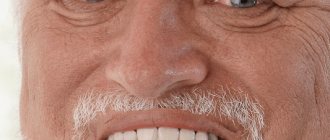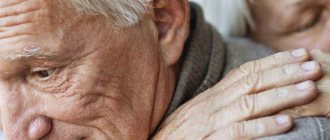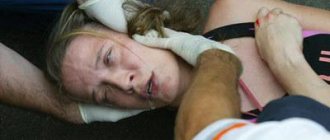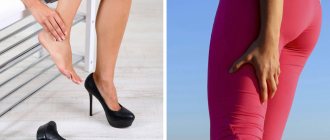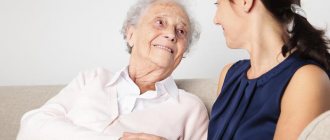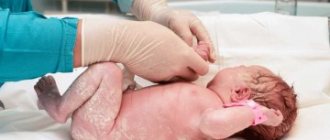Cramps are involuntary muscle contractions due to overexertion; they manifest themselves in a paroxysmal manner. Convulsions occur suddenly and, as a rule, last a short time, but can be repeated at some intervals.
In some cases, cramps can be quite painful, and children and older people are much more likely to experience pain. Such muscle contractions primarily occur at night, when the body relaxes during sleep, or during periods of muscle activity when the body is too tense.
Cramps are mainly localized in the calf muscles, thighs, back, abdomen and neck. Moreover, cramps can affect both one muscle and an entire group of muscles.
Causes of
cramps
The appearance of cramps is caused by insufficient blood circulation in the muscles, which is especially affected by physical overexertion. Sometimes the body is responsible for the occurrence of seizures due to the influence of external factors - sharp loud sounds, pricking the body with a needle, excessive consumption of alcoholic beverages.
Sports enthusiasts often experience a lack of salts in the body due to increased sweating, which can also cause cramps.
Monotonous activity forces certain muscle groups to tense, so cramps may occur even when using a mouse for a long time or when typing on the keyboard for a long time.
At night, seizures become a manifestation of some physiological and mental disorders, for example, if poor blood flow is combined with stress.
Increased stress on the muscles leads to fatigue and, as a result, cramps occur. This is especially true for people whose work activity primarily takes place in a standing position.
In some cases, seizures become a consequence of diseases of the nervous system, such as tetanus, epilepsy, neurosis, or symptoms of various poisonings, dysfunction of the endocrine glands and insufficient metabolism.
In children, seizures appear due to insufficient development of the brain and nerve endings, due to weak inhibitory mechanisms. Predisposes to convulsive activity exposure to harmful factors during gestation, during childbirth and in the postpartum period. During pregnancy, these can include severe toxicosis, intrauterine infections, and drug intoxication. During childbirth, mechanical damage to the baby's brain can occur. The postpartum phase is dangerous due to the occurrence of infectious diseases, complications after vaccinations, metabolic disorders, and traumatic brain injuries.
Manifestations of spasms in the calf muscles are considered an independent disease, but can also be a consequence of some disease, for example, varicose veins. Their occurrence is caused by long walking or swimming in insufficiently warm water.
The muscles of the glottis may also be affected by convulsions, and caustic gases or irritating odors become irritants. Often this can be fraught with disruption of the nutritional process, changes in the functions of the heart and brain, and respiratory arrest.
Symptoms of seizures
Cramps can range from mild to very severe. Mild seizures are characterized by confusion, snorting, temporary visual disturbances, convulsive tingling and twitching in certain areas of the body. In the moderate form, along with the above-described symptoms, fecal and urinary incontinence and short-term fainting occur.
The most dangerous form of seizures is an epileptic seizure. This results in an unreasonable feeling of fear, numbness, dizziness, nausea, increased salivation, foaming at the mouth, and impaired eye and head movements. Such convulsions last more than two minutes, then loss of consciousness occurs.
Treatment of seizures
Treatment of seizures involves, first of all, treating the disease that caused them. The following are used as anticonvulsants:
- Hexacmidine;
- Phenobarbital;
- Difenin;
- Benzonal.
Massage of the affected area, warming up, and proper work and rest regime have an excellent effect. With periodically recurring convulsions, urgent medical attention is required, otherwise cerebral edema, breathing problems and other vital functions may occur.
In hot weather, you should never allow your body to become dehydrated. For frequent cramps, the patient should drink cool water with added salt (1 tsp per 1 liter of water).
To improve blood circulation in the affected areas, it is advisable to apply alternating hot and cold compresses to the affected areas.
It is impossible to stop an attack that has already begun. To help a patient in such a situation, it is necessary to call an ambulance as quickly as possible and try to prevent possible damage and injury that a person may inflict on himself during convulsions.
You can try to eliminate your own cramps by stretching the affected muscles. You need to gather your strength, endure the pain and try to stretch out so that the muscles lengthen.
If loss of consciousness occurs during general convulsions, this is a reason to suspect the presence of epilepsy. While waiting for medical help, you should ensure that the sick person is in a calm position that maximizes muscle relaxation. If you have breathing problems, you need to provide fresh air by opening windows or allowing the patient to breathe oxygen from a filled oxygen bag.
If a person often experiences epileptic seizures, it is advisable to constantly carry with you, in your pocket or bag, a sheet of information about the duration and number of seizures. This will allow doctors to provide the necessary assistance in a timely manner.
As a general action, the area affected by the cramps is needed. At the same time, blood flow improves and the affected muscles receive plenty of much-needed oxygen delivered by the blood. Particularly effective are fairly strong stroking followed by sliding; the direction of such movements should be directed towards the heart muscle.
The effect of massage can be enhanced if you combine it with aromatherapy. Oils of lavender, juniper, rosemary, and marjoram will be useful. Because even in diluted form, which is a prerequisite, essential oils will cause skin irritation, blood flow will increase, blood vessels will dilate and, as a result, muscles will relax and cramps will go away.
II. Treatment of seizures with folk remedies
Types of seizures
Depending on the cause, seizures may be episodic or random - spasms. In some patients, they appear or intensify under the influence of external stimuli (sudden loud sound, needle pricking the body), or with alcohol abuse. The cramp can be in one muscle or cover a group of muscles.
Sudden, spasmodic muscle tension (tonic spasm) can last for some time (usually a minute) and is often accompanied by sharp pain. Such a cramp most often occurs in the calf muscle after a long walk, as well as during swimming in a completely healthy person.
If a cramp occurs while swimming, you should stop moving your legs and extend your foot using your healthy foot. Convulsive contraction (spasm) of the muscles of the glottis, which can be caused by irritating gases and odors, often leads to cessation of breathing. Spasm of the muscles of the arterial vessels of various organs causes malnutrition and changes in the functions of these organs (for example, the brain, heart, etc.). Muscle spasm causes a sudden attack of cramping pain (colic).
Usually, seizures are a symptom of a disease, so you need to see a doctor to determine their cause and treatment. General convulsions with loss of consciousness are a symptom of epilepsy. If seizures occur, you should immediately call a doctor. Before his arrival, it is necessary to create a calm environment. Lay the patient down so that he can relax his muscles. If breathing is impaired, it is necessary to provide a supply of fresh air or give oxygen from an oxygen bag. In hot weather, to prevent dehydration, give cold water to drink, to which table salt has been added (1 teaspoon of salt per liter of water).
Diagnostic methods
In most cases, seizures go away on their own, but if a person experiences pain during an attack, he should consult a doctor. At the clinic, he should talk about the symptoms that bother you and the possible reasons for their occurrence. Next, the patient will be referred for a general blood test. To identify disturbances in the functioning of internal organs or systems, a computed tomography or MRI will be required. Treatment of seizures is carried out by a therapist, neurologist, psychologist and neurosurgeon.
In the network of CMRI clinics, the following methods are used to confirm the diagnosis and clarify the causes of seizures:
Symptoms of seizures
Symptoms of seizures range from mild to very severe. The most dangerous form of seizures is an epileptic seizure.
- possible darkening of the eyes, confusion, snorting and puffing;
- tingling and convulsive twitching in parts of the body;
- urinary and/or fecal incontinence;
- short-term loss of consciousness;
A special condition preceding epileptic attacks, which has various manifestations: a sudden feeling of fear, nausea, a feeling of numbness, dizziness. If severe salivation, foaming from the mouth, sudden fainting, loss of consciousness, sharp muscle spasms with twitching of the legs, deviation in the direction of the eyes and head (eye deviation) occur, urgent medical attention is required.
Causes of seizures
Cramps occur due to insufficient blood circulation in the muscles, especially during physical exertion. For some, convulsions appear and intensify when exposed to external stimuli - a needle pricking the body, sudden loud sounds, alcohol abuse.
A factor in the development of cramps in athletes is a lack of salt in the body, caused by increased sweating. Even monotonous, repetitive movements, such as typing on a keyboard or moving a computer mouse, can cause seizures.
Night cramps are the result of a complex of psychophysiological disorders (reduced blood circulation and stress). If the same muscle groups are under load, then when tired they can also be subject to convulsive contractions. This primarily applies to people who work while standing. Sometimes seizures are a consequence of diseases of the nervous system (epilepsy, tetanus or neurosis), poisoning, metabolic disorders or the activity of the endocrine glands.
Convulsions in children are associated with insufficient maturity of the brain and nerve fibers, weak inhibitory mechanisms. The development of convulsive readiness is influenced by harmful factors during the mother’s pregnancy, childbirth and the postpartum phase, acting on the baby’s nervous system. Before birth, this may be toxicosis, intrauterine infection, drug intoxication, acute and chronic illnesses of the mother; during childbirth – mechanical damage to the fetal brain; after childbirth - infectious diseases, metabolic disorders, complications after vaccination, traumatic brain injuries.
Spasms of the calf muscles are an independent disease, and can accompany any disease (for example, varicose veins). They occur during long walking or swimming. Convulsive contractions of the muscles of the glottis can be caused by irritating odors or gases. They often lead to eating disorders and changes in the functions of the brain and heart, and respiratory arrest.
Mechanism of muscle contraction
Muscle fiber contraction occurs in the following order:
The nerve impulse originates in the brain and is transmitted along the nerve to the muscle fiber.
Through a substance (transmitter) produced in the body, acetylcholine, an electrical impulse is transmitted from the nerve to the surface of the muscle fiber.
The impulse spreads throughout the muscle fiber and penetrates deep through special T-shaped tubules.
Transfer of excitation from T-shaped tubules to cisterns. Tanks are special cellular formations containing large quantities of calcium ions. As a result, calcium channels open and calcium enters the intracellular space.
Calcium triggers the process of mutual convergence of actin and myosin filaments by activating and restructuring the active centers of troponin and tropomyosin.
ATP is an integral component of the above process as it supports the process of bringing together the actin and myosin filaments. ATP promotes the detachment of myosin heads and the release of its active centers. In other words, without ATP, the muscle is not able to contract, since it cannot relax before it does so.
As the actin and myosin filaments come closer together, the sarcomere shortens and the muscle fiber itself and the entire muscle contract.
Violation at any of the above stages can lead to either a lack of muscle contraction or a state of constant contraction, that is, cramps.
Treatment of seizures
Treatment of seizures involves, first of all, treating the disease that caused them. The following are used as anticonvulsants:
- Hexacmidine;
- Phenobarbital;
- Difenin;
- Benzonal.
Massage of the affected area, warming up, and proper work and rest regime have an excellent effect. With periodically recurring convulsions, urgent medical attention is required, otherwise cerebral edema, breathing problems and other vital functions may occur.
In hot weather, you should never allow your body to become dehydrated. For frequent cramps, the patient should drink cool water with added salt (1 tsp per 1 liter of water). To improve blood circulation in the affected areas, it is advisable to apply alternating hot and cold compresses to the affected areas.
It is impossible to stop an attack that has already begun. To help a patient in such a situation, it is necessary to call an ambulance as quickly as possible and try to prevent possible damage and injury that a person may inflict on himself during convulsions. You can try to eliminate your own cramps by stretching the affected muscles. You need to gather your strength, endure the pain and try to stretch out so that the muscles lengthen.
If loss of consciousness occurs during general convulsions, this is a reason to suspect the presence of epilepsy. While waiting for medical help, you should ensure that the sick person is in a calm position that maximizes muscle relaxation. If you have breathing problems, you need to provide fresh air by opening windows or allowing the patient to breathe oxygen from a filled oxygen bag.
If a person often experiences epileptic seizures, it is advisable to constantly carry with you, in your pocket or bag, a sheet of information about the duration and number of seizures. This will allow doctors to provide the necessary assistance in a timely manner.
As a general action, gently massage the area affected by the cramps. At the same time, blood flow improves and the affected muscles receive plenty of much-needed oxygen delivered by the blood. Particularly effective are fairly strong stroking followed by sliding; the direction of such movements should be directed towards the heart muscle.
The effect of massage can be enhanced if you combine it with aromatherapy. Oils of lavender, juniper, rosemary, and marjoram will be useful. Because even in diluted form, which is a prerequisite, essential oils will cause skin irritation, blood flow will increase, blood vessels will dilate and, as a result, muscles will relax and cramps will go away.
How to prevent seizures
Treatment must begin as early as possible to stop the progression of the disease and changes in the psyche. After the first manifestation, you need to undergo electroencephalography and, if a cluster of nerve cells is established, treatment is prescribed, which is carried out for a long time. The drugs are discontinued after two to three years of use - only then can a complete cure be said.
Proper nutrition is the cure for cramps
Review your diet to increase the content of the following microelements:
- Calcium
is known to be found in dairy products. But low-fat dairy products should be avoided, as calcium is less absorbed from them, often causing kidney problems. So prefer dairy products with a fat content of 3%. Calcium deficiency is common in pregnant women. To form the baby’s tissues, a lot of calcium is needed, and the baby “takes” the microelement from the mother. - Magnesium
can be obtained from watermelon, tahini halva and buckwheat, products that hold the record for the content of this substance. - Sodium
is found in table salt. Deficiency is rare. The exception is athletes and manual workers who lose sodium through sweat during intense training or work. If you exercise more than 45 minutes a day or work hard, drink alkaline mineral water instead of regular water, preferably without gases. - Potassium
can be obtained from baked potatoes, oranges and bananas.
All these microelements can be consumed in the form of dietary supplements; there are special supplements for the prevention of seizures.
Increase your intake of vitamins D and E. To do this, you need to eat sprats in oil, chicken yolk, sunflower and soybean oils. Or take fat-soluble vitamins in the form of fat capsules or oil drops. Eat more foods containing vitamins B2 and B6, namely liver, oatmeal, beans, and beef kidneys. Most vitamin complexes contain enough of these substances, but “natural” sources are better. Taurine is present in seafood and meat. A lack of this amino acid increases the likelihood of seizures several times. Taurine can be purchased as a dietary supplement.
Drink enough water, at least 2.2 liters per day. Limit sugar, not only in the form of granulated sugar, but also in various products. Try not to buy products containing more than 10 g of sugar per 100 g of product. It is also a means of preventing such a formidable and common disease as diabetes. Consume less caffeine. If you cannot live without coffee, limit yourself to 1-2 servings of weak coffee, replacing the remaining servings with decaffeinated coffee or chicory drink.
What needs to be changed in your lifestyle?
General fatigue, muscle fatigue, monotonous sedentary work, nervous tension, high body temperature, large loss of water and table salt by the body can be the causes of seizures.
- Do your physical activity correctly; the quest to set a world record for a novice athlete can result in a broken leg as a result of a cramp. Be especially careful in the gym. When working with the exercise machine, do not make sudden movements. Drink water during class.
- If you are prone to seizures, you should not swim in too cold water, at least do not swim alone, since it is almost impossible to completely eliminate the possibility of seizures, and the threat to life is serious.
- Choose the right posture when sitting. You can put your legs under yourself for no more than 3-5 minutes, otherwise you risk breaking both legs at once as a result of a cramp - this is not so uncommon.
Exercises to prevent seizures
Recent research shows that cramps occur much less frequently if the sufferer begins to regularly stretch their leg muscles. The muscle should not be held in a stretched state for more than 20 seconds. Ideally, the muscle should be stretched as much as possible for 10–15 seconds. All exercises are performed very slowly. Stretching should be accompanied by deep, slow breathing. It is especially pleasant to do exercises in the morning as part of exercises, and you will feel how every cell of your body is filled with oxygen. Don't do the same exercise several times in a row. Each should be done in 2-3 approaches, alternating exercises:
- Starting position: you lie on your back, knees bent, ankles resting on the floor. Then you lift one of the legs (working) and place the other one on your knee. Next, grab your other leg and pull it towards you until you feel tension in your working leg. Switch legs.
- Starting position: lie on your stomach, arms and legs relaxed. Then you need to bend your working leg at the knee, reach it with your hands, and pull it towards your head, raising your knee. Repeat with the other leg.
- Starting position: sitting, back straight, legs brought together. Reach towards the tips of your feet, trying to keep your toes as far away from your heels as possible.
Also, some yoga asanas are useful for preventing cramps; it is good to use the “Sun Salutation” complex for morning warm-up.
Treatment with folk remedies
The following recipes are quite effective for treating seizures at home:
- Adonis in spring. Take 1–2 teaspoons of dry crushed Adonis vernacular herb per 1 cup of boiling water. Take 1 tbsp for adults. spoon 3 times a day. For two-year-old children – 5-6 drops; six years old - 15 drops; twelve year old - 2 teaspoons 5-6 times a day.
- Birch (buds). Brew 2 teaspoons of birch buds as tea in 1 glass of boiling water. Drink the infusion 2 days in 3 doses.
- Carnation. Take no more than 10 grains (620 mg) of cloves with sugar.
- Mustard oil. When cramping the muscles of the arms and legs, rub the sore spots with mustard oil.
- Broadleaf ragwort. Take 20 g of broadleaf groundsel roots per 200 ml of boiling water. Take 40 drops 1 time per day. Take tincture of ragwort roots: 25 g of roots per 100 ml of 70% alcohol. Take 30–40 drops 1 time per day; for persistent pain – 3 times a day.
- Cinquefoil goose. A decoction of the herb cinquefoil can be used for seizures of various types (even for tetanus). It is better to use the decoction as a prophylactic, as it acts slowly.
- Lemon. In the morning and evening, lubricate the soles of your feet with fresh lemon juice, do not wipe with anything, put on socks and shoes only after the juice has dried on the soles. The course of treatment is no more than two weeks. Use for leg muscle cramps.
- Linden (color). 1.5 tbsp. pour spoons of finely chopped linden flowers with 1 cup of boiling water; brew, leave for 20 minutes; strain. Take 1 tbsp. spoon 3 times a day.
- Poppy. Carefully dry the petals of the poppy, grind into powder and prepare a decoction with milk and honey. The petals can also be used as a vodka tincture.
Cramps in the arms and legs: causes of muscle spasms and their treatment
The cause of muscle spasm can be anything: from physical overexertion to the presence of a malignant tumor. If involuntary muscle contractions occur frequently, you should consult a doctor. Single spasms can be relieved on your own at home; recurring ones require examination and appropriate treatment.
Definition
A cramp is an involuntary contraction of striated or smooth muscle fibers, accompanied by pain. The work of skeletal muscles is regulated by the central nervous system by direct and reverse impulses. If one of the chain links malfunctions, uncontrollable spasms are observed.
Any muscle can contract pathologically, but most often patients complain of damage to the limbs. Pain during a cramp occurs due to pinched nerve fibers with a sharp increase in muscle tone. It can be either short-term or persistent, up to long-term disability.
Varieties
Spasms of skeletal muscles are divided into tonic and clonic; a mixed version is also possible.
The first type is a prolonged tension of muscle fibers, in which the spasmed muscle changes shape and is fixed in this form for some time.
Intense pain occurs, which either goes away after relaxation or persists (sometimes for quite a long time).
This type of spasm is caused by overexcitation of the subcortical areas of the brain. A characteristic feature of tonic muscle cramps is their occurrence at night, during periods of rest.
Clonic contractions appear as twitching, which is explained by the alternating contraction and relaxation of muscles.
The reasons that cause them are varied, but they all lead to stimulation of the cerebral cortex.
When a specific muscle area is affected, trembling is observed; in the case of a generalized seizure, the entire body is affected. The latter is observed during a classic epileptic attack.
Common reasons
Various factors influence muscle tone. Cramps of the limbs or the whole body occur for the following most common reasons:
- Epilepsy and other neurological disorders, especially in the elderly.
- Infectious diseases affecting the nervous system (tetanus, for example).
- Brain cysts and tumors.
- Intoxication – mushrooms, salts of heavy metals, medications.
- Neurotic states such as psychosis.
- Deficiency of certain microelements due to water-electrolyte imbalance.
- High fever in children under 6 years of age.
Physiological factors can also cause the disorder. Twitching of the hands after strenuous work with the hands in those who work physically or spend a lot of time at the keyboard. Cramps also occur after intense physical training (strength training).
Hypothermia is another possible cause of muscle spasms. Tonic contractions of muscle fibers can affect both internal organs (in this case, their work is disrupted) and skeletal muscles. Leg and hand cramps may have the same causes.
Hand cramps
A common phenomenon among those who work physically.
No less often, knowledge workers - musicians, managers and other people who spend a lot of time at the computer - complain of spasmodic attacks.
In the first case, spasms are caused by muscle overstrain and occur more often at night. Patients complain of waking up at night due to pain in their arms. In the second, painful sensations can occur at any time of the day.
Spasms of the upper extremities can be triggered by hypothermia and tight sleeves of clothing.
These factors slow down blood flow, muscle fibers do not receive enough oxygen and nutrients, and therefore contract spastically. Muscular hypertonicity can be observed after intense physical training.
Often the cause is monotonous movements during needlework and other activities related to fine motor skills of the hands.
All situations develop due to overstrain of the arm muscles. What can be done? If you can’t work less, you should pay attention to the content of vitamins and microelements in food and water consumption.
Cramps are caused by a lack of calcium and magnesium with iron. Taking diuretic drugs increases the risk of developing convulsive syndrome.
That is, you need to eat right, including iron-containing foods, fruits, and vegetables in your diet.
A few simple movements will help relieve a sudden spasm. If your hand is cramped, you need to shake it vigorously several times and also clench your fingers into a fist. Then move them, simulating typing on a keyboard. A massage with simultaneous forced flexion of the little finger gives a good effect. You can also take a relaxing hot bath.
If seizures recur regularly, consultation with a neurologist is necessary. Spasms and numbness of the left hand deserve special attention - they are often a harbinger of myocardial infarction.
Leg cramps
A sharp painful contraction of the calf, thigh muscles or arch of the foot is familiar to almost everyone. For some time, such an attack limits mobility, and pain may persist after it. The main causes of sudden cramps in the lower limb:
- Intense physical activity during the day - a long walk, training, or other active movements. As a result, cramps may occur at night.
- Professional activities associated with static muscle tension - work “on your feet” (salespeople, teachers).
- Sudden hypothermia when swimming in the heat.
- Iron deficiency and hormonal conditions during pregnancy often manifest as night cramps.
- The foot cramps if you have flat feet.
- Dehydration with impaired water-electrolyte balance, especially as a result of taking certain medications (diuretics, for example), is accompanied by convulsions.
- Atherosclerosis, varicose veins, thrombophlebitis, incipient obliterating endarteritis or amyotrophic lateral sclerosis.
- Psycho-emotional stress.
What to do if your leg cramps? As an emergency aid for cramping in your calves or foot muscles, it is recommended to sit down and pull your toes towards you. In case of quadriceps cramp, you need to stand and bend the affected leg at the knee, bringing your heel as close as possible to your buttock. Self-massage, a blow to the spasmodic area, or a needle prick also help to relax the muscle fibers.
Diagnosis and treatment
The listed first aid measures are intended solely to relieve painful cramping, but its causes may require special treatment. Often spasms are a symptom of serious diseases, so their regular nature requires a full examination.
Diagnostics includes physical examination, laboratory and instrumental research methods. Based on their results, appropriate treatment is prescribed.
Medicines
Knowing the causes of pathological contractions, you can get rid of them using various groups of medications. According to indications, the following may be prescribed:
- Benzodiazepines (Phenazepam), which relieve nervous excitement, muscle spasms, have a sedative effect.
- Neuroleptics - Aminazine - help cope with insomnia, psychosis, and moderately lower blood pressure.
- Cardiac glycosides such as Digoxin are indicated for heart failure and poor circulation.
- Iron and magnesium supplements for deficiency of these microelements.
- Fibrinolytics are used in cases of convulsive syndrome caused by ischemic stroke to destroy the blood clot.
In early childhood (up to 6 years), specific febrile convulsions caused by increased temperature may occur. Treatment in this case comes down to taking antipyretics and NSAIDs.
Physical exercise
If cramps in the legs and hands occur due to overwork, heavy or monotonous work, you should rest as much as possible.
You need to sleep at least 6 hours, take a warm shower or a relaxing bath before bed. It is advisable to lift weights in several stages, in small parts.
Take regular breaks at work at least once an hour; gymnastics will be useful to relieve tension in your hands and fingers.
When playing sports, especially strength sports, you should dose the load wisely and also do a warm-up to warm up.
Nutrition
Diet is critical for iron, magnesium and calcium deficiency. The deficiency of these microelements is determined during a blood test. Along with taking special medications, it is recommended to adjust your diet. Red meat, liver, buckwheat, pomegranates and apples will help compensate for the lack of iron in anemia.
There is a lot of magnesium in fresh vegetables, legumes, nuts, and calcium in dairy products. It is important to maintain a drinking regime, consuming enough liquid. But at the same time, it is better not to drink carbonated and tonic drinks.
Surgery
If the seizure syndrome occurs due to the presence of tumors, abnormalities or vascular diseases, surgical intervention is necessary. During the operation, tumors, blood clots, and sections of veins (for varicose veins) are removed. In case of obliterating endarteritis, bypass surgery is performed to restore vascular patency.
Folk remedies
Alternative medicine offers many ways to relieve and treat muscle cramps. First of all, it is recommended to carry out warming procedures: compresses, salt baths, apply mustard plasters or pepper plaster.
You can take an infusion of linden blossom, adonis, or a decoction of viburnum bark internally. The latter is also used to rub the muscle areas affected by spasms. Therapy with folk remedies has contraindications and can only be used with the approval of a doctor.
Prevention
The occurrence of muscle convulsions can in most cases be prevented if any diseases are identified and treated in a timely manner. Compliance with the work and rest regime, proper nutrition and distribution of physical activity are of great importance.
You should also give up smoking, alcohol abuse and tonic drinks. Pregnant women need to regularly determine the content of microelements in the blood to avoid their deficiency.
Source: https://neuromed.online/sudorogi-v-rukah/


